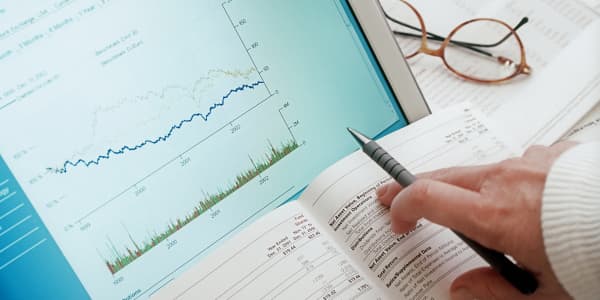Most economists believe interest rates will rise this year. But with global growth slowing and depressed oil prices putting a lid on inflation, their conviction wanes almost daily. Both India and Switzerland have announced unexpected rate cuts this year. Meanwhile, prominent thinkers, including Jeffrey Gundlach and Paul Krugman, have been skeptical of higher rates all along.
Where does that leave individuals trying to figure out the fixed-income portion of their retirement portfolio? The simple answer: Stay diversified, and prepare for wider price swings and lower overall returns. In general, experts advise, shorten maturities and stick with higher credit quality. "Look at fixed income as defensive ballast, not a vehicle for growth," said Jacob Wolkowitz, investment manager at Accredited Investors in Edina, Minnesota.
Just a few weeks ago, Wall Street was rallying around the idea that the U.S. economy was in liftoff and that it would push interest rates broadly higher all year. That would crush the holders of long-term bonds as bond prices sink.
Then oil tumbled to $45 a barrel and Saudi Prince Al-Waleed declared that the price would never again see $100. "That is a game changer," said Edward Yardeni, chief investment strategist at Yardeni Research. It suggests the global economy is weakening and might drag down growth in the U.S. late in the year. Low oil prices also mitigate any inflation worries, further raising doubts about higher rates.
Read MoreWhy US interest rates are heading lower
Gundlach at DoubleLine Capital has said the T-bond yield could keep falling—below the modern low of 1.38 percent if oil dips further; Nobel Laureate Krugman has said a short-term Fed rate boost is "probably not" in the cards this year. If they are right, bonds might again provide a stocklike return in 2015. Last year T-bonds returned 11 percent.
Yet even with oil prices down, the more common view remains that the Fed will boost its short-term Fed funds target rate to a high of 0.5 percent from 0.25 percent at midyear and possibly again before year-end, and bond yields will begin to climb in the second half. Solid growth of around 3 percent and an improving picture for jobs and wages is the main reason. The rate climb could last years, analysts say, finally reversing a three-decade trend that has been brutal on savers but rewarded bond fund investors with total returns well in excess of the interest payments they received.
Dan Shackelford, portfolio manager of the T. Rowe Price New Income Fund, said rate increases this year will be "modest and gradual," taking the T-bond yield from around 2 percent to 2.75 percent. Others believe 3 percent or higher is likely by year-end. Ford O'Neil, co-manager of the Fidelity Total Bond Fund, believes it may take three to five years for the T-bond yield to reach 4 percent. "Rates can't rise much in a fragile world economy," he said. Still, any rise would cut into the gains of bondholders, and the chief risk is that rates rise more quickly than is now expected.
Read MoreBond rally cools after Beige Book, weak auction
Treasury bonds may be most vulnerable. With a paltry 1.9 percent yield, the 10-year T-bond doesn't offer a lot of income to offset a decline in price. Meanwhile, junk bonds and emerging markets bonds may yield more than 5 percent but don't seem any safer, said Kathy A. Jones, fixed-income strategist at Schwab Center for Financial Research. She believes yields on these riskier credits likely will rise fastest and lead to the sharpest drop in price.
Jones advises sticking with investment-grade corporate bonds for safety and income and shortening the average maturity to about five years. Values on these bonds won't bounce around so much, and they are easier to hold to maturity, when proceeds can be reinvested at higher yields. The easiest way to do this is through an index like Barclay's Capital U.S. Aggregate Bond, which holds investment-grade debt with an average maturity of 4.7 years.
Financial advisors also suggest leaning toward multisector credit and, in some cases, unconstrained bond funds that can be more opportunistic. Since the recession, bond yields have been falling and "you could pretty much just enjoy the ride" in passive funds, said Carolyn Gibbs, senior fixed-income strategist at Invesco Fixed Income, which manages $250 billion. But that won't work as rates reverse in a period with so many crosscurrents.
Read MoreRepositioning your portfolio to beat rising interest rates
An active manager that can cross borders and sectors may navigate weakness in Asia and Europe coupled with growth in the U.S., among other dislocations. A word of warning: Some of these funds have the ability to sell short and make other high-risk bets. If you seek stability, look carefully at the holdings and strategy of any unconstrained fund—and remember, you are betting on the manager, not the direction of interest rates.
Wolkowitz at Accredited Investor likes the multisector approach and is putting his clients in Aberdeen Total Return and Loomis Sayles Bond. Another fan is Jason Brooks, president of Indelible Wealth Group, who is putting clients in Pimco Income fund and Metropolitan West Total Return Bond. "These funds have the ability to react and be where you need to be," said Brooks. That sounds pretty good in a fast-changing climate for fixed income.




